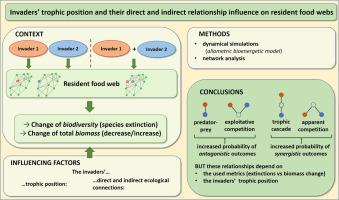入侵者的营养地位及其对居民食物网的直接和间接影响
IF 3.2
3区 环境科学与生态学
Q2 ECOLOGY
引用次数: 0
摘要
许多生态系统正在同时经历多种外来物种的殖民化和传播。入侵者往往通过减少居住物种的种群规模,甚至通过灭绝来减少群落的多样性,从而对群落产生负面影响。它们之间的直接和间接相互作用可以放大或减轻它们对土著社区的影响。在这项研究中,我们比较了两种入侵者在两种情况下对常驻模型食物网的影响:分别入侵和同时入侵。我们从两个角度考察了常驻食物网的响应:作为多样性损失衡量标准的灭绝物种数量,以及食物网总生物量的净变化。利用基于异速生物能量模型的动态模拟,我们在计算机上跟踪了这些变化,并比较了两种情景的结果。我们研究了入侵者的相对营养位置及其直接/间接相互作用如何影响其共同入侵结果的加性或非加性性质。我们的研究结果证实了之前的实地和实验观察,表明当共同发生的入侵者占据不同的营养水平时,如果一个入侵者捕食另一个入侵者,它们的综合效应可能会受到抑制。此外,我们已经表明,当入侵者形成一个营养级联或共享一个共同的捕食者时,协同效应的可能性会增加。然而,我们也表明,所有这些关系都受到以下因素的影响:(1)用于跟踪居住社区变化的度量;(2)入侵发生时的营养水平;(3)入侵者是否有捕食者(居民或其他入侵者)。本文章由计算机程序翻译,如有差异,请以英文原文为准。

Invaders’ trophic position and their direct and indirect relationship influence on resident food webs
Many ecosystems are undergoing simultaneous colonization and spread of multiple alien species. Invaders often negatively affect communities by reducing population sizes of resident species or even decreasing community diversity through extinctions. Direct and indirect interactions between them can amplify or mitigate their impacts on native communities. In this study, we compare the effects of two invaders on the resident model food webs under two scenarios: separate versus simultaneous invasion.
We examined the resident food webs’ response from two perspectives: the number of extinct species as a measure of diversity loss, and the net change in total biomass of the food web. Using dynamic simulations based on the Allometric Bioenergetic Model, we tracked these changes in silico and compared the results of the two scenarios. We examined how the invaders’ relative trophic positions and their direct/indirect interactions influence the additive or non-additive nature of the outcomes of their co-invasion.
Our results have corroborated previous field and experimental observations, showing that when co-occurring invaders occupy different trophic levels, their combined effects may be dampened if one invader preys on the other. Further, we have shown that the probability of synergistic effect increases when invaders form a trophic cascade or share a common predator. However, we have also shown that all these relationships are influenced by i) the metric used to track changes in the resident community, ii) the trophic level at which the invasion occurs, and iii) whether the invader has a predator (either resident or another invader).
求助全文
通过发布文献求助,成功后即可免费获取论文全文。
去求助
来源期刊

Ecological Modelling
环境科学-生态学
CiteScore
5.60
自引率
6.50%
发文量
259
审稿时长
69 days
期刊介绍:
The journal is concerned with the use of mathematical models and systems analysis for the description of ecological processes and for the sustainable management of resources. Human activity and well-being are dependent on and integrated with the functioning of ecosystems and the services they provide. We aim to understand these basic ecosystem functions using mathematical and conceptual modelling, systems analysis, thermodynamics, computer simulations, and ecological theory. This leads to a preference for process-based models embedded in theory with explicit causative agents as opposed to strictly statistical or correlative descriptions. These modelling methods can be applied to a wide spectrum of issues ranging from basic ecology to human ecology to socio-ecological systems. The journal welcomes research articles, short communications, review articles, letters to the editor, book reviews, and other communications. The journal also supports the activities of the [International Society of Ecological Modelling (ISEM)](http://www.isemna.org/).
 求助内容:
求助内容: 应助结果提醒方式:
应助结果提醒方式:


